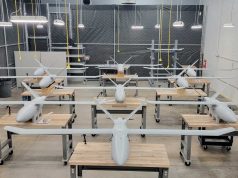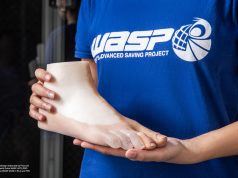California-based Barrelhand has explored an ultra-lightweight design with its Monolith watch. The 3D-printed titanium case makes the watch 40% lighter.
The current iteration of the chassis is monolithically printed from aerospace-grade Ti 6Al-4V titanium, one of the many aerospace-grade materials Barrelhand is exploring. The use of skeletonized lugs and internal lattice structures has reduced overall weight by over 40% while maintaining full structural integrity. The company designed and optimized the chassis with 3D printing in mind. The result is a geometry with various hollowed areas and supporting lattice structures that could not have been achieved with any other manufacturing method.
“Designing something that can be 3D printed monolithically without the constraints of traditional manufacturing is the holy grail of engineering. It allows us to create almost any complex geometry optimized for the harsh conditions of space. I loved going through the design process and watching the chassis transform almost organically from the engineering requirements into something that feels like art because it is a function of the engineering,” says Karel Bachand, founder and chief engineer, Barrelhand.
The Monolith chassis is the result of a collaboration with Materialise, a leading 3D printing solutions provider with extensive experience in the aerospace industry. Materialise has established its metal 3D printing center of excellence in Bremen, Germany, where dedicated engineers with years of experience offer the full range of AM expertise from design to special parameter setting and finishing. Materialise and Barrelhand are much more than just printing a watch case. They are creating new standards for the design, production and quality assurance of 3D printed parts for volume production, while meeting ISO standards.
The technology used to 3D print the case is called direct metal laser sintering (DMLS) and works by fusing thin layers of fine-grained metal powder (each grain is only 25-50 microns in size, about four times thinner than a human hair). DMLS is the same technique SpaceX uses to 3D print components for rocket engines. The process removes many of the limitations of traditional manufacturing methods, and Barrelhand was able to create a structure that is ideally suited to the challenges of space – both in terms of weight and strength requirements.
While additive manufacturing offers unprecedented design freedom, that doesn’t mean it’s easy to work with. During development, the team around Monolith needed to understand how the unique forces and temperatures of the construction process would affect the design to ensure a consistent, high-quality end result. 3D printing ultimately made it possible to create a chassis with complex structures and internal cavities. At the same time, the design is self-supporting during the printing process (i.e., there are no overhangs greater than 45 degrees). The result is organic shapes that are easy to print and conform to the design.
“The design freedom of additive manufacturing allowed us to perfectly combine innovation and lightweighting to suit the visionary approach of the project. With our in-depth knowledge from design to printing to finishing, we were able to perfectly advise Barrelhand in developing a professional, production-ready product for space,” says Philip Buchholz, Innovation Manager Metal 3D Printing, Materialise.
Weighing just 10 grams (equivalent to the weight of 10 paper clips) for the entire titanium case, it will allow Monolith to move into a new category of ultra-light watches, true to the company’s mission to build products for the next chapter of space exploration.
Find out more about Barrelhand at barrelhand.com.
Subscribe to our Newsletter
3DPResso is a weekly newsletter that links to the most exciting global stories from the 3D printing and additive manufacturing industry.
























